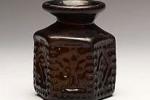Blend: Abramelin Jewish Holy Anointing Oil
I use the authentic ingredients (extra virgin olive oil, essential oils of calamus, cassia, cinnamon and myrrh) in original proportions adjusted for the use of therapeutic grade essential oils (rather than macerated, powdered or from resins).
The holy anointing oil described in Exodus 30:22-25 was created from 500 shekels (about 6 kg) of myrrh, half as much (about 3 kg) of fragrant cinnamon, 250 shekels (about 3 kg) of fragrant cane (kanabos, variously translated as calamus or cannabis), 500 shekels (about 6kg) of cassia, and a hin (about 4 L) of olive oil.
The oil was used to anoint the vessels of the Tabernacle 30:26 and the High Priest and is traditionally regarded as the oil used by prophets to anoint Saul, David, and other kings of ancient Israel.
Here is the recipe for Jewish Holy Oil from the Bible:
Take thou also unto thee principal spices, of pure myrrh five hundred [shekels], and of sweet cinnamon half so much, [even] two hundred and fifty [shekels], and of sweet calamus two hundred and fifty [shekels], And of cassia five hundred [shekels], after the shekel of the sanctuary, and of oil olive an hin: And thou shalt make it an oil of holy ointment, an ointment compounded after the art of the apothecary: it shall be an holy anointing oil. (Exodus 30:22-33)
The Bible lists five ingredients: Myrrh, Cinnamon, Cassia, Calamus, and Olive oil.
The four ingredients listed by Abraham of Worms in "The Book of the Sacred Magic of Abramelin the Mage" are Myrrh, Cinnamon, Calamus, and Olive oil.
Since Cinnamon and Cassia are two species of the same Cinnamomum genus, their doubling up into one name by the medieval author Abraham of Worms is not unexpected. His reasons for doing so may have been prompted by a pious decision to avoid duplicating true Holy Oil, or by a tacit admission that in medieval Europe, it was difficult to obtain Cinnamon and Cassia as separate products.
This formula does not burn the skin as it uses original proportions, and cinnamon leaf rather than bark oil.
Flask image thanks to Wikimedia Commons and the Walters Art Museum:
This circa 600 (Late Antique) hexagonal flask is decorated with a menorah, a palm tree, and geometric forms. Many similar flasks substitute crosses for the Jewish symbol, indicating that a single workshop served the needs of both Christians and Jews in the area around Jerusalem. Menorah flasks, often discovered in graves, were used as funerary offerings, and to hold holy oil that came from synagogues and holy places on Mount Zion.
Image thanks to James Tissot, Public domain, via Wikimedia Commons




